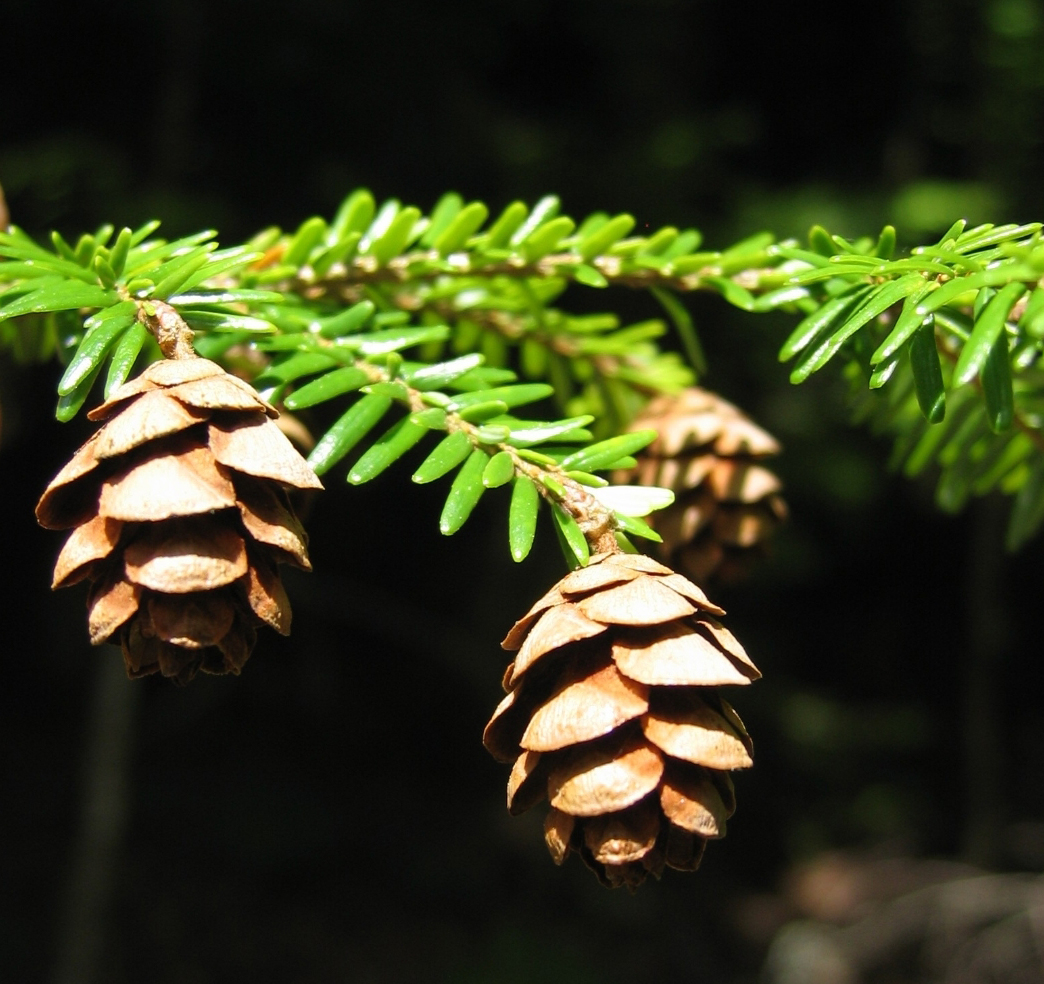Soft and gracefully pyramidal in youth with tapering trunk becoming pendulously pyramidal with age. An excellent subject for moist, well drained acidic soils, rock or sandy soils.
Physical characteristics
Leaf: Evergreen, flat, single needles, 1/2 inch long, tapering to a dull point, primarily two-ranked, shiny dark green above, 2 lines of white stomata below.
Flower: Species is monoecious; males yellow, small, round; females light green at branch tips.
Fruit: Ovoid light brown cone, 3/4 inch long with rounded, entire scales, maturing in early fall.
Twig: Slender, gray-brown in color; buds are very small.
Bark: Initially gray-brown and smooth then turning scaly; older trees are red-brown with wide ridges and furrows; when cut or broken, purple streaks are obvious.
Form: A medium sized tree with a dense, conical crown, fine branches and a drooping terminal shoot reaching up to 80 feet tall, typically a poor natural pruner.
ID Features
- pyramidal, medium-sized, needle evergreen tree with horizontal to pendulous, graceful branches.
- short flattened needles.
- needles held in 2-ranked fashion.
- T. caroliniana, with which T. canadensis is often confused, has more of its needles spirally distributed around its shoots.
- shoots pubescent.
- has minutely serrulate leaf margins, while T. caroliniana has smooth margins.
- twigs roughened by persistent leaf bases remaining after needles fall.
- numerous, small cones.
Ecological characteristics
In the United States, eastern hemlock occurs throughout New England, the mid-Atlantic states, and the Lake States, and extends south in the Appalachian Mountains to northern Georgia and Alabama and west from the mountains into Indiana, western Ohio, and western Kentucky. At its northern limit, eastern hemlock ranges along the southern border of Canada from southern Ontario to Cape Breton Island, Nova Scotia.
Eastern hemlock occurs as a dominant or codominant in coniferous and
mixed-hardwood forests. It is often the only conifer present in mixed
mesophytic forests of the eastern United States
Importance to the ecosystem
► Eastern hemlock dominates composition and function across riparian ecotones in Ohio. ► Additional species are infrequent, but respond to environmental gradients. ► Hemlock suppresses plant diversity, productivity, and resource availability. ► Biotic influence may override abiotic factors in other foundation species ecosystems.
Ohio’s eastern hemlock (Tsuga canadensis (L.) Carr.) ecosystems provide important ecological and economic benefits to the state. As a foundation species, eastern hemlock has a major influence on forest structure and functional processes. Eastern hemlock is also dominant in several popular outdoor recreation and tourist areas in Ohio.
Relationship with other species
Non-human: It provides protective cover. Deer and rabbits eat its lacy needles, birds such as Chickadees, and small mammals enjoy the small seeds inside the tiny cones, and porcupines chew its inner bark.
Humans: Lumber production from eastern hemlock reached its peak between 1890 and 1910. Primary uses were in light framing, sheathing, roofing, subflooring, boxes, crates, and general millwork. Much of the present production is used in pulping or newsprint and wrapping papers, but the demand for hemlock lumber appears to be increasing again.
Pests: The Hemlock Woolly Adelgid (Adelgis tsugae), native to Japan and China, has devastated the Hemlock populations of the Eastern U.S. since it was first reported in 1950. Although horticulturalists are using chemical injections and biocontrol methods, the aphid-like insect continues to spread quickly, increasing its range by about 10 miles per year.
| Other Pests: | Scale, Weevil, Mite. Insects increase in number on plants fertilized with too much nitrogen. Consider applying a labeled pesticide before applying nitrogen fertilizer. |
| Diseases: | Root Rot, Canker. |
Other interesting facts
-
Emily Dickinson’s poem The Hemlock may have been inspired by the Hemlocks that her father planted on the family’s estate in the 1860s, which have since been restored.
-
Although sometimes confused (in name) with Poison Hemlock, Eastern Hemlock is not toxic to humans and makes a delicious, Vitamin C-rich tea.
-
The Eastern Hemlock is the official state tree of Pennsylvania.
- Native Americans used the inner bark, roots, and needles of the Eastern Hemlock in antiseptics, cold medicines, and remedies for rheumatism and arthritis. In times of famine, they ate the inner bark. Its soft, lightweight wood makes lousy firewood, but it does work well in crates, general construction, and paper pulp. Tannins in the tree’s bark soften leather.
Sources:
http://www.sciencedirect.com/science/article/pii/S0378112712006378
http://www.na.fs.fed.us/pubs/silvics_manual/Volume_1/tsuga/canadensis.htm
http://zipcodezoo.com/Plants/T/Tsuga_canadensis/
http://dendro.cnre.vt.edu/dendrology/syllabus/factsheet.cfm?ID=116
Page Drafted By: Julia Giza
Fast Facts
- Common Name: Eastern Hemlock
- Scientific Name: Tsuga canadensis
- Family: Pinaceae
 The Hemlock Woolly AdelgidThe Hemlock Woolly Adelgid
The Hemlock Woolly AdelgidThe Hemlock Woolly Adelgid
Fun Facts:
- Today, this stately 50-80’ tall tree thrives in moist, shady, north facing locations. Eastern Hemlocks can live up to 1,000 years, unless they succumb to the hemlock wooly adelgid, an introduced pest that affects hemlock forests throughout the eastern U.S.
- Numerous cultivars of Tsuga canadensis have been developed, including compact shrubs , dwarfs , and graceful trees . Wood of the species tends to be brittle and inferior to that of the other North American hemlocks.
- Tsuga Japanese name. canadensis of Canada.
- This tree also ranks high for ornamental planting.
ES 203: SPRING FLORA OF THE GREAT LAKES
You can highlight additional information here or add more related links.
• You can link to other LFC.com pages
• You can link to an outside url
• You can link to a files such as a pdf


